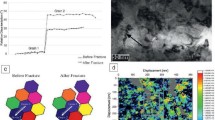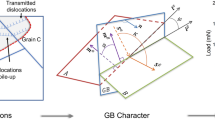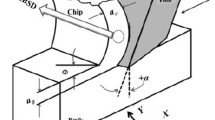Abstract
Background
Dislocation dynamic simulations are intended as a tool to understand and predict the mechanical behavior of metallic materials, but its prediction has never been directly verified by experiments due to differences in specimen strain rate and size.
Objective
In this work, a comprehensive experimental framework is proposed to attempt direct comparison between experiments and discrete dislocation dynamics (DDD) modelling.
Methods
By integrating high-throughput sample fabrication and a customized testing apparatus, the sample size and strain rate typically employed in DDD simulations are explored experimentally. Constitutive properties such as stress-strain response are measured, and microstructural information is obtained from transmission electron microscopy (TEM) imaging, electron backscatter diffraction (EBSD), and TEM-based orientation mapping.
Results
Magnesium and copper were selected, as case studies, to demonstrate the newly developed experimental procedure. Measured stress-strain responses for Mg are consistent with those obtained with a miniaturized Hopkison bar experiments. By exploiting the validated workflow, the effect of strain rate on micropillar heterogeneous deformation and associated dislocation plasticity were revealed.
Conclusion
The work establishes a methodology for the systematic study of not only metals but also other materials and structures at the microscale and high strain rates.














Similar content being viewed by others
Change history
15 September 2021
A Correction to this paper has been published: https://doi.org/10.1007/s11340-021-00773-y
References
Taylor GF (1924) A Method of Drawing Metallic Filaments and a Discussion of their Properties and Uses. Phys Rev 23:655–660. https://doi.org/10.1103/PhysRev.23.655
Brenner SS (1956a) The growth of whiskers by the reduction of metal salts. Acta Metall 4:62–74. https://doi.org/10.1016/0001-6160(56)90111-0
Brenner SS (1956b) Tensile strength of whiskers. J Appl Phys 27:1484–1491. https://doi.org/10.1063/1.1722294
Uchic MD, Dimiduk DM, Florando JN, Nix WD (2003) Exploring specimen size effects in plastic deformation of Ni 3(Al, Ta). Mater Res Soc Symp - Proc 753:27–32. https://doi.org/10.1557/proc-753-bb1.4
Uchic MD, Dimiduk DM, Florando JN, Nix WD (2004) Sample dimensions influence strength and crystal plasticity. Science (80- ) 305:986–989. https://doi.org/10.1126/science.1098993
Bernal RA, Aghaei A, Lee S et al (2015) Intrinsic Bauschinger Effect and Recoverable Plasticity in Pentatwinned Silver Nanowires Tested in Tension. Nano Lett 15:139–146. https://doi.org/10.1021/nl503237t
Ramachandramoorthy R, Gao W, Bernal R, Espinosa H (2016) High Strain Rate Tensile Testing of Silver Nanowires: Rate-Dependent Brittle-to-Ductile Transition. Nano Lett 16:255–263. https://doi.org/10.1021/acs.nanolett.5b03630
Park HS, Cai W, Espinosa HD, Huang H (2009) Mechanics of Crystalline Nanowires. MRS Bull 34:178–183. https://doi.org/10.1557/mrs2009.49
Tang H, Schwarz KW, Espinosa HD (2008) Dislocation-Source Shutdown and the Plastic Behavior of Single-Crystal Micropillars. Phys Rev Lett 100:185503. https://doi.org/10.1103/PhysRevLett.100.185503
Zhu T, Li J, Ogata S, Yip S (2009) Mechanics of Ultra-Strength Materials. MRS Bull 34:167–172. https://doi.org/10.1557/mrs2009.47
Jennings AT, Li J, Greer JR (2011) Emergence of strain-rate sensitivity in Cu nanopillars: Transition from dislocation multiplication to dislocation nucleation. Acta Mater 59:5627–5637. https://doi.org/10.1016/j.actamat.2011.05.038
Jeong J, Alfreider M, Konetschnik R et al (2018) In-situ TEM observation of 101¯2 twin-dominated deformation of Mg pillars: Twinning mechanism, size effects and rate dependency. Acta Mater 158:407–421. https://doi.org/10.1016/j.actamat.2018.07.027
Casem D, Ligda J, Walter T et al (2020) Strain-Rate Sensitivity of Nanocrystalline Cu–10Ta to 700,000/s. J Dyn Behav Mater 6:24–33. https://doi.org/10.1007/s40870-019-00223-w
Sills RB, Bertin N, Aghaei A, Cai W (2018) Dislocation Networks and the Microstructural Origin of Strain Hardening. Phys Rev Lett 121:085501. https://doi.org/10.1103/PhysRevLett.121.085501
Guillonneau G, Mieszala M, Wehrs J et al (2018) Nanomechanical testing at high strain rates: New instrumentation for nanoindentation and microcompression. Mater Des 148:39–48. https://doi.org/10.1016/j.matdes.2018.03.050
Ramachandramoorthy R (2019) Deformation and Failure in Metallic Nanowires Under Stress-relaxation. Northwestern University, Cyclic and High Strain Rate Loading Conditions
Ben-David E, Tepper-Faran T, Rittel D, Shilo D (2014) A New Methodology for Uniaxial Tensile Testing of Free-Standing Thin Films at High Strain-Rates. Exp Mech 54:1687–1696. https://doi.org/10.1007/s11340-014-9911-1
Greer JR, Oliver WC, Nix WD (2005) Size dependence of mechanical properties of gold at the micron scale in the absence of strain gradients. Acta Mater 53:1821–1830. https://doi.org/10.1016/j.actamat.2004.12.031
Hütsch J, Lilleodden ET (2014) The influence of focused-ion beam preparation technique on microcompression investigations: Lathe vs. annular milling. Scr Mater 77:49–51. https://doi.org/10.1016/j.scriptamat.2014.01.016
Echlin MP, Titus MS, Straw M et al (2017) Materials response to glancing incidence femtosecond laser ablation. Acta Mater 124:37–46. https://doi.org/10.1016/j.actamat.2016.10.055
Zhang H, Schuster BE, Wei Q, Ramesh KT (2006) The design of accurate micro-compression experiments. Scr Mater 54:181–186. https://doi.org/10.1016/j.scriptamat.2005.06.043
Uchic MD, Dimiduk DM (2005) A methodology to investigate size scale effects in crystalline plasticity using uniaxial compression testing. Mater Sci Eng A 400–401:268–278. https://doi.org/10.1016/j.msea.2005.03.082
Zhao X, Strickland DJ, Derlet PM et al (2015) In situ measurements of a homogeneous to heterogeneous transition in the plastic response of ion-irradiated 〈111〉 Ni microspecimens. Acta Mater 88:121–135. https://doi.org/10.1016/j.actamat.2015.01.007
Li Q (2011) Dynamic mechanical response of magnesium single crystal under compression loading: Experiments, model, and simulations. J Appl Phys 109 https://doi.org/10.1063/1.3585870
Obara T, Yoshinga H, Morozumi S (1973) {112̄2}〈1123〉 Slip system in magnesium. Acta Metall 21:845–853. https://doi.org/10.1016/0001-6160(73)90141-7
Larson BC, Yang W, Ice GE et al (2002) Three-dimensional X-ray structural microscopy with submicrometre resolution. Nature 415:887–890. https://doi.org/10.1038/415887a
Acknowledgements
H. D. Espinosa gratefully acknowledge financial support from the Army Research Lab through award No. W911NF1220022. The authors thank Dr. Robert Stroud (NANOMEGAS USA) for acquiring the TEM nano-mapping data reported in Fig. 14(d) and acknowledge the Argonne National Lab - Center for Nanomaterial user awards 57577, 57549, and 67558.
Author information
Authors and Affiliations
Corresponding author
Ethics declarations
Conflict of Interests
The authors declare that they have no conflict of interest.
Additional information
Publisher’s Note
Springer Nature remains neutral with regard to jurisdictional claims in published maps and institutional affiliations.
Rights and permissions
About this article
Cite this article
Lin, Z., Magagnosc, D.J., Wen, J. et al. In-Situ SEM High Strain Rate Testing of Large Diameter Micropillars Followed by TEM and EBSD Postmortem Analysis. Exp Mech 61, 739–752 (2021). https://doi.org/10.1007/s11340-021-00693-x
Received:
Accepted:
Published:
Issue Date:
DOI: https://doi.org/10.1007/s11340-021-00693-x




